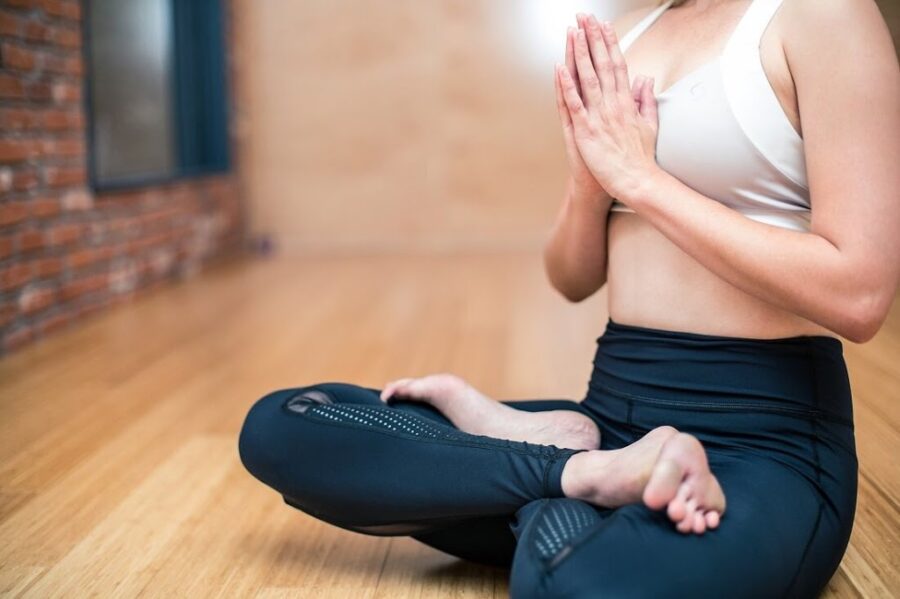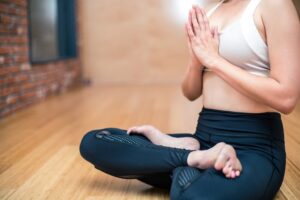Yoga is a great stress reliever and it has been shown to ease anxiety and depression as well. When you shift your focus from your body to the breath, it relieves stress and also eases physical tension.
Yoga has positive effects on mild depression and sleep problems, and it improves the symptoms of psychiatric disorders.
So, here are some yoga poses (or asanas) that can help you to improve your mental health:
Table of Contents
Tadasana
It is commonly known as palm tree posture or mountain pose. It is a good starting position for lots of other standing poses. This posture promotes stillness in both the mind and the body, you learn to just ‘be’.
How To Do:
- Start standing up with your toes touching the floor and heels slightly apart
- spread your toes wide apart
- stretch your shoulders, arms, and chest upwards while your toes bear your weight
- feel the stretch in your body from head to feet
- hold this position for about 20-30 seconds.
Benefits:
- helps to correct posture
- helps to increase height for growing children
- helps to balance your body
- increase strength and flexibility of feet, legs, and hips
Cautions:
- Avoid this pose if you have-
1. insomnia
2. frequent headaches
3. low blood pressure
Vrikshasana
It is commonly known as tree pose. This asana involves focus and concentration, and its best to channelize this in the morning when your mind is relaxed and stress-free.
How To Do:
- While standing straight with ankles flat on the ground, lift one leg and place the ankle on the inner part of your opposite thigh
- bend your knees outward
- balance and stretch your arms upward and connect your palms
Benefits:
- it makes you stable, flexible, and patient.
- enhances concentration and focus
- helps relieve premenstrual symptoms such as leg and abdominal cramps
- strengthens the spine while improving both balance and posture
- relieves stress and anxiety as concentration is needed for balancing the body on one leg
Cautions:
- avoid if-
1. insomnia or migraine
2. arthritis
Anjaneyasana
It is also known as a crescent moon yoga pose. This yoga pose stretches and strengthens so many of the areas of the body at once.
How To Do:
- take wide stands and hands on the hips
- right toe points out 90 degrees and turns towards the right thigh
- place left knee on the mat and left toe pointing behind
- join the palms above the head
- urge the back and look up raising the chin as high as possible
- hold the pose for few seconds
Benefits:
- stretches thighs, groins, and opens the chest
- increases your ability to concentrate and also builds core awareness
- stimulates the digestive system and reproductive organs
Cautions:
- avoid if you have-
1. heart problems
2. high blood pressure
3. knee injuries
Padmasana
It is also known as the lotus position. This asana is perfect for meditation, in this posture body finds itself in perfect equilibrium.
Traditional beliefs say that “This asana destroys all your disease and awaken kundalini.”
How To Do:
- sit on the mat with legs straight
- bends the left leg, grab the left foot with your hands and place it over the right thigh
- then, bend the right leg at the knee, grab the right foot, and place it on your left thigh
- place one palm upon the other on the heels close to naval
- keep the spine, head, neck erect
- relax the body completely
- close your eyes and breathe normally
Benefits:
- reduces tension in muscles and brings blood pressure under control
- relaxes the mind
- helps pregnant ladies during childbirth
- reduces menstrual discomfort
Cautions:
- avoid if you have-
1. ankle injury
2. knee injury
Balasana
It is commonly known as the child’s pose. It is an easy yoga asana that can even be performed by beginners. It calms your brain and helps to relieve stress and fatigue.
How To Do:
- sit on your heels
- extend your hands forward
- and slowly put your forehead on the floor
- arms are often overhead with the palms on the ground
- breathe and hold for 5-10 seconds
Benefits:
- gently stretches the hips, thighs, and ankles
- helps alleviate stress and anxiety
Cautions:
- avoid if you have-
1. knee injury
2. diarrhea
3. infection in the stomach
- if you are pregnant
Vajrasana
It is a kneeling pose, diamond, or thunderbolt pose and its name is derived from Sanskrit word ‘vajra’, which means diamond or thunderbolt. It is a meditative pose that is known to improve focus, calmness. It helps relieve nerve issues and indigestion.
It is the only asana which can be practiced right after having food.
How To Do:
- first, sit straight
- stretch out the legs
- slowly bend the legs one by one
- adjust your feet to be closer to the buttocks
- stretch the hands forward to place your arms covering the knees
- stay in the position for a while
Benefits:
- this asana aids digestion
- strengthens the back and relieves patients suffering from lower back problems
- good posture for meditation or pranayama
Cautions:
- avoid if you have-
1. knee injury
2. ankle injury
Natrajasana
It is also known as the dancer’s pose. It is the main asana of lord shiva, it helps to balance your body and bring deep relaxation to the body and mind.
How To Do:
- start with mountain pose
- bend your right leg backward
- and holds right ankle with right hand extended
- your left arm straight out in front
- try to move your right leg upward as much as you can
- hold for 20 to 30 seconds
- slowly come back to the starting position
- repeat this with left leg
Benefits:
- stretches the spine and quadriceps
- develops concentration
- promotes clarity
- helps to reduce weight
- improve the digestive system
- releases stress and calm your mind
Cautions:
- avoid in case of spinal injury
- while doing this asana if you feel any problem in the back, leave it there
Pashchimottasana
It is commonly known as a seated forward bend.
Traditional beliefs say that “Pashchimottasana increases appetite, reduces obesity, and cure diseases.”
This pose helps relieve stress and improves your mood.
How To Do:
-
sit with the legs stretched ahead of you
-
keep spine erect and toes flexed towards you
-
raise both your arms above the head and stretch up
-
bend forwards from the hips, chin move in towards the toes
-
hold the right wrist in front of the feet
-
place your head to the knees
-
hold as long as you can
Benefits:
-
improves digestion
-
helps relieve the symptoms of menstruation
-
excellent for runners who tend to have tight hamstring
Cautions:
-
avoid if you have an injury in your arms, hips, ankles, or shoulders
-
don’t force yourself in this pose
-
if you are too tight to get that much bend, just do what you can without pain
Virabhadrasana
It is commonly known as the warrior’s pose. Virabhadra is a mythological character created by Lord Shiva from where it derives its name.
It is beneficial for those who require focus and steady breathing.
How To Do:
- start with Tadasana
- take your right leg forward
- lift your arms up
- take the hands on the side
- and drop your hip down till your thighs are parallel to the floor
- stay in this position for 10-20 seconds
- repeat on another side
Benefits:
- beneficial for those with deskbound jobs
- helps increase stamina
- strengthens the arms, thighs, shoulders, and back muscles, all in one go
Cautions:
- avoid if you have-
1. high blood pressure
2. arthritis
3. suffering or suffered from diarrhea
Uttanasana
It is commonly called a standing forward bend. In this pose, we are encouraging the flow of blood back to the brain, providing it fresh blood and nutrients.
How To Do:
- start with Tadasana
- raise your arms towards the sky, palms facing towards each other
- extends your spine up
- bend from the waist and isolate your body
- bring hands behind the legs and hold ankles or you can simply put them on the ground
- hold the posture for a while
Benefits:
- calms the mind and soothes the nerves
- reduces stress, anxiety, depression, and fatigue
- relieves tension in the spine, neck, and back
Cautions:
- women who are pregnant or menstruating should not bend completely
- avoid if you feel high pressure to your head and injury in the lower back
Salamba Sarvangasana
It is simply known as a shoulder stand. It is called the queen of all asanas as it benefits the whole body. It helps calm the brain, cures mild depression, and relieve stress.
How To Do:
- lie down on your back
- bring your legs all the way up slowly
- push your hips forward and bring your chest close to chin
- hold the posture for as long as you can
Benefits:
- relieves the symptoms of menopause
- strengthens the heart and respiratory system
- improves blood circulation and increase the flexibility of the body
Cautions:
- avoid if you have-
1. high blood pressure, diarrhea
2. menstruation
3. headache, neck injury
Chakrasana
It is known as the wheel’s pose. In gymnastics and acrobatics, this position is called a back bridge. It helps in your calmness and focus.
How To Do:
- while standing, place your arms high above your head
- keeping your back straight, bend backward
- do this slowly until palms reach the floor behind you
- keep your ankles firmly on the ground
Benefits:
- this asana brings more flexibility to your spine
- good for infertility and asthma
- beneficial for heart
Cautions:
- if you are suffering from wrist or shoulder problems, it is recommended to avoid this pose
Adho Mukha Vrikshasana
It is a basic handstand but not for beginners, it is difficult to pose for a lot of people not because it takes a lot of strength but also people have fear to do it. It circulates blood to your head, which can be energizing and conversely helps to calm you.
How To Do:
- bring your hands about 4 inches away from the wall
- come into the downward-facing dog pose
- walk your feet in
- slowly bring one leg up then the second leg
- and hold this position for 5-10 seconds
Benefits:
- stretches the belly
- helps to improve your sense of balance
- helps relieve mild depression and stress
- strengthens shoulders, arms, and wrists
Cautions:
- avoid if neck, shoulder, or back injury
- avoid in menstruation
Savasana
It is commonly known as corpse pose. It is the most important pose and it allows your body to fully enjoy and feel everything that you did.
It conditions the body to release stress and may improve your sense of physical and emotional well being.
How To Do:
- lay down on your back
- extend your legs on the ground
- allow your feet to gently fall to the sides
- bring your arms to the sides with your arms facing up
- close your eyes, maintain even breathing
Benefits:
- relaxes the body
- reduces headache, fatigue, and insomnia
- helps to lower blood pressure
Cautions:
- during pregnancy, raise chest and head on the bolster
- do not fall asleep during the asana
Setubandhasana
It is known as bridge pose. It opens up the upper body energy centers. It calms the brain, reduces anxiety, stress, and depression.
How To Do:
- lie down on your back
- bend the knees make sure your entire back is flat on the floor, no gaps, no arches
- hands-on the floor
- raise the hips, bring them as high as you can
- hold this position
Benefits:
- strengthens the back muscles
- aids high blood pressure, sinusitis, asthma, and insomnia
- improves blood circulation
- help relieves menstrual pain
Cautions:
- avoid doing this pose if you are suffering from neck or back injuries
These yoga asanas will calm your mind, improve focus, your mood, patience, and also build confidence.
Also, you can try Relaxation Techniques to improve your mental health.


























Great work ��
very nice… i really like your blog…
great content
Grt job bro 👍
Thankss Bro❤
Thankyou ☺
Thankyou☺
Thankyou.. Means a lot❤
I always love your posts and I appreciate your cautions on all the yoga poses.
Worth reading! Yoga improves focus and confidence that is much needed in the current scenario.
I love that you include cautions on your poses. Being new to yoga, I often just go along with what ever video I’ve found on youtube and try to follow best I can. I like knowing the benefits to each pose. Thank you!